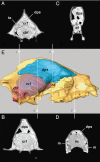The first skull of the earliest giant panda
- PMID: 17578912
- PMCID: PMC1904166
- DOI: 10.1073/pnas.0704198104
The first skull of the earliest giant panda
Abstract
Fossils of the giant panda Ailuropoda (Order Carnivora, Family Ursidae) are largely isolated teeth, mandibles, and a few rare skulls, known from the late Pliocene to late Pleistocene in China and Southeast Asia. Much of this material represents a Pleistocene chronospecies, Ailuropoda baconi, an animal larger than the living giant panda, Ailuropoda melanoleuca. The earliest certain record of Ailuropoda is the late Pliocene chronospecies, Ailuropoda microta, smaller than either A. baconi or A. melanoleuca, and previously known only from teeth and a few mandibles from karst caves in south China. Here, we report the discovery of the first skull of A. microta, establishing its cranial anatomy and demonstrating that the specialized cranial and dental adaptations of Ailuropoda for durophagous feeding behavior centered on bamboo were already evident in this late Pliocene species. The skull from Jinyin cave (Guangxi) and dental remains from other karst localities in southeastern China show that Ailuropoda microta occupied south China from approximately 2 to 2.4 Myr ago after a marked global climatic deterioration. Dental and basicranial anatomy indicate a less specialized morphology early in the history of the lineage and support derivation of the giant panda from the Miocene Asian ursid Ailurarctos.
Conflict of interest statement
The authors declare no conflict of interest.
Figures





References
-
- McKenna MC, Bell SK. Classification of Mammals Above the Species Level. New York: Columbia Univ Press; 1997.
-
- Matthew WD, Granger W. Bull Am Mus Nat Hist. 1923;48:563–598.
-
- Colbert EH, Hooijer DA. Bull Am Mus Nat Hist. 1953;102:1–134.
-
- Pei WZ. Mem Inst Vert Palaeontol Palaeanthropol Acad Sin. 1987;18:104–106.
-
- Woodward AS. Proc Zool Soc London. 1915;1915:425–428.
Publication types
MeSH terms
LinkOut - more resources
Full Text Sources

